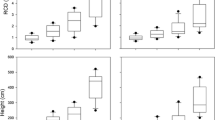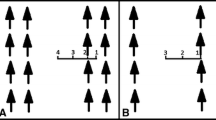Abstract
This study quantitatively compared the sapling (height 62–289 cm) architecture and growth of Castanopsis cuspidata and Quercus glauca, both of which are major components in the temperate zone of western Japan, under shaded light conditions in secondary forest. When the sapling architectures were compared at the same support mass (trunk + branch mass), C. cuspidata had a larger crown area but a smaller height gain than did Q. glauca owing to the allocation of more biomass to lateral branches in C. cuspidata. The above-ground relative growth rate (RGR) of C. cuspidata (0.442 g g−1 year−1) was nearly twice that of Q. glauca (0.256 g g−1 year−1), primarily as a result of a greater total leaf area per above-ground biomass (LAR) in C. cuspidata (56 cm2 g−1) as compared to Q. glauca (33 cm2 g−1). Because it has a disadvantage in height gain, related to its allocation pattern of biomass, C. cuspidata realized the same height growth (RGRH) as Q. glauca, despite the large biomass production. The great potential for photosynthesis in C. cuspidata, which results from its vigorous lateral spreading, is presumed to give it a long-term advantage over Q. glauca in the shaded forest understory. Q. glauca invests preferentially in trunk biomass, possibly giving it an advantage in sunny sites as opposed to a shaded forest understory.
Similar content being viewed by others
Author information
Authors and Affiliations
Corresponding author
About this article
Cite this article
Cho, M., Kawamura, K. & Takeda, H. Sapling architecture and growth in the co-occurring species Castanopsis cuspidata and Quercus glauca in a secondary forest in western Japan. J For Res 10, 143–150 (2005). https://doi.org/10.1007/s10310-004-0124-9
Received:
Accepted:
Issue Date:
DOI: https://doi.org/10.1007/s10310-004-0124-9




